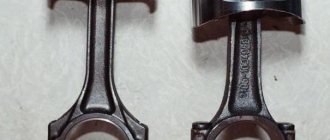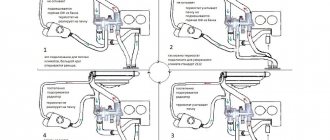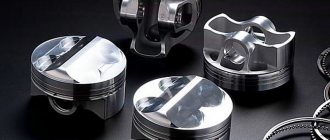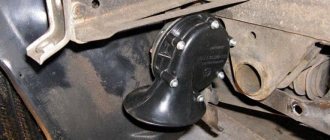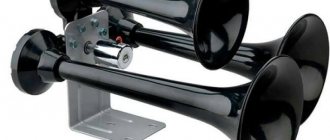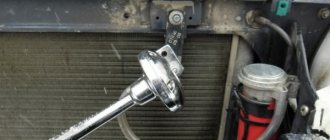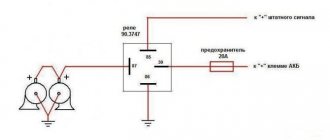How to install a Volgov signal on a Priora
I decided to install 2 Volgov signals. But on the drive I saw enough that it is necessary to install relays and fuses, but I don’t understand at all why this relay is needed if we take the plus from the standard chip? I’m not good at electrical, but looking at the diagrams, I don’t plug it in at all...after all, there is a standard relay K8 for the signal and the signal fuse F5 also takes power from the battery. The factory signal requires 5-6A, and the Volgov signals 14A. Why can’t you just replace the F5 fuse from 10A to 15A or 20A (to give full power to the volgosignals) and take the plus for the signals from the standard chip and that’s it? Here is a diagram of the standard installation:
Types and causes of malfunctions
Statistics show that 70 percent of Lada Kalina car owners, to one degree or another, encounter problems associated with incorrect operation or complete failure of the horn. The fact is that the horn itself is installed between the radiator and the car body, so it is exposed to increased negative effects of an aggressive environment (dampness, high temperature, cold, icing). The main, main reason for the failure of the unit is the oxidation of contacts and conductive elements.
How to install a Volga signal
Remove the front bumper (instructions for XRAY, Vesta, Grant, Priora, Kalina, Largus). If it was decided not to remove the standard sound signal (if necessary, you can return to the initial version), then we are looking for a suitable place to install signals from the Volga. Most often they are placed on the front bumper amplifier (on standard mounting bolts), behind the radiator grille or under the headlights on brackets.
Priora fuse box diagram
| Fuse no. | Current strength, A | "Standard" and "Norm" | “Norma” with air conditioning and “luxury” |
| F1 | 25 | Engine cooling radiator fan | Reserve |
| F2 | 25 | Heated rear window | Mounting block, rear window heating relay (contacts). Electrical package controller, contact “10” of XP2 block. Rear window heating element. |
| F3 | 10 | Right headlight, high beam | Right headlight, high beam lamp. Instrument cluster, headlight high beam indicator. |
| F4 | 10 | Left headlight, high beam | |
| F5 | 10 | Sound signal | Mounting block, horn relay. Sound signal. |
| F6 | 7.5 | Left headlight, low beam | |
| F7 | 7.5 | Right headlight, low beam | |
| F8 | 10 | Alarm signal | Mounting block, alarm relay. Alarm sound. |
| F9 | 25 | Priora heater fuse | Reserve |
| F10 | 7.5/10* | Interior lighting, instrument panels, brake light | Instrument cluster, pin “20”. Brake light switch. Brake light bulbs. Interior lighting unit. Interior lighting. The door sill light on the right front door. Additional brake signal. |
| F11 | 10/20* | Wiper | Mounting block, high speed windshield wiper relay. Switch for cleaners and washers, contact “53a”. Wiper and washer switch, contact “53ah”. Heated rear window switch. Mounting block, rear window heating relay (winding). Windshield wiper motor. Rear window wiper motor (2171,2172). Windshield washer motor. Rear window washer motor (2171,2172). Airbag control unit, pin “25”. |
| F12 | 20/10* | Terminal 15 devices | Instrument cluster, pin “21”. Electrical package controller, contact “9” of block X2. Electromechanical power steering control unit, contact “1” of block X2. Reversing light switch. Reversing lamps. Parking system control unit, contacts “11” and “14”. |
| F13 | 15 | Cigarette lighter fuse Priora | |
| F14 | 5 | Left headlight, parking light, license plate light, trunk light | Side light lamps (left side) Instrument cluster, main light indicator License plate lights Trunk light Electrical package controller, pin “12” of block X2 |
| F15 | 5 | Right headlight, parking light | Side light lamps (right side) Glove compartment lamp |
| F16 | 10 | Terminal 15 ABS | Hydraulic unit, contact "18" |
| F17 | 10 | Left fog lamp | |
| F18 | 10 | Right fog lamp | |
| F19 | 15 | Seat heating | Seat heating switch, contact "1" Front seat heaters |
| F20 | 5/10* | Immobilizer control unit | Recirculation switch (switch on) Mounting block, relay for low beam headlights and parking lights (automatic lighting control system) Heater electric fan relay Automatic lighting control switch Windshield wiper and external lighting control unit, contacts “3”, “11” Automatic climate control system controller installation, pin “1” Automatic window cleaning system sensor (rain sensor), pin “1” |
| F21 | 7.5/5* | Rear fog lights | Light switch, contact "30" Diagnostic block, contact "16" Clock Automatic climate control system controller, contact "14" |
| F22 | -/20* | Reserve | Windshield wiper motor (automatic) Mounting block, windshield wiper relay and windshield wiper high speed relay, (contacts) |
| F23 | -/7.5* | Reserve | Windshield wipers and external lighting control unit, pin “20” |
| F24-F30 | Reserve | ||
| F31 | 30 | Electrical package control unit | Electrical package controller, terminal “2” of block X1 Electrical package controller, terminal “3” of block X1 Driver’s door module, pin “6” Threshold light of the left front door |
| F32 | Reserve | ||
How to choose
Having decided to replace a relay or fuse in a Priora, take full responsibility for their selection and purchase. Under no circumstances should you buy cheap parts of unknown quality and origin.
It is better to give preference to original products produced by VAZ. As a last resort, buy relays or fuses from one of the well-known companies, such as Bosh, Hella or Tesla.
Replacing the sound signal on a Lada Vesta is a simple procedure that any owner should be able to perform. After all, driving without a properly working horn is a priori unsafe, and taking a car to a service station due to such a breakdown is an unreasonably large amount of time. However, replacement in the event of a malfunction is not the only need. Many people are simply not satisfied with the volume or tone of the sound signal, and they replace the standard Vesta components with alternative ones. Therefore, both of these paths need to be considered in more detail.
Sports steering wheel (Pros and Cons)
Conclusion
over your safety. The worst option is if you buy a steering wheel that is made of hard material and is not capable of deformation.
above the price. a branded steering wheel is usually manufactured at the factory, under the careful supervision of specialists
This kind of enterprise sometimes specializes exclusively in “steering wheels”, so attention, effort, knowledge and resources are aimed only at making a steering wheel, which, once picked up, cannot be let go. The price of a high-quality steering wheel cannot be lower than a standard factory one.
undergoing technical inspection
You will not pass MOT if you have an alternative steering wheel installed and do not have a certificate confirming that this steering wheel complies with GOST.
xn—2111-43da1a8c.xn—p1ai
Recommendations
Comments 50
You can install one set without a relay and not worry, but if you install 2 sets or more, then you cannot do without a more powerful (than standard) relay. I have 2 sets of Volgov horns, for them I took a separate + from the battery and through a relay.
I’ve been driving with Volgov signals for seven years, everything works fine, I connected it without any modifications, I took the car from new, I didn’t even bother whether there was a relay there or not, I signal often.
I installed Volga signals on the Priora, without a relay, without replacing the standard fuse. This is not the first car I have changed the signal. Nothing ever burned down anywhere. I use the signal, but I didn’t go to a wedding while driving.
don't get carried away! I installed it without a relay and I’m happy, everything is fine. and I like to honk at all sorts of woodpeckers)
I’ve been driving with Volga signals for 4 years without additional relays and everything is fine! At a friend’s wedding, he honked a lot because the rest of the cars had factory beeps)))))
install a relay and that’s it... the chip itself will be a control plus for you, they’ve already given you the circuit... do it right.
I don’t know what’s wrong with the signal and what’s connected with it, I just want to screw your brains with what you wrote. The fuse that you wanted to change to a larger one is needed not by the signal, but by the wiring, like any other, that is, if you increase it and load the wire, it will melt and then light up, and the oversized fuse will not even light up unless it is shorted to ground... this It’s a mistake of many people and you have to remember that fuses, circuit breakers at home, are installed for adjustment, not for devices... regarding the relay, just take it out and it says on it how many amperes can be loaded on it, it’s simple. and by the cross-section of the wire you can determine the maximum current for it and you will understand what is the maximum for wiring in this case, you can install a fuse, download the sign on the Internet for yourself))
Thank you) Yes, I already realized that I was stupid)) I’ll install an additional relay)
I don’t know what’s wrong with the signal and what’s connected with it, I just want to screw your brains with what you wrote. The fuse that you wanted to change to a larger one is needed not by the signal, but by the wiring, like any other, that is, if you increase it and load the wire, it will melt and then light up, and the oversized fuse will not even light up unless it is shorted to ground... this It’s a mistake of many people and you have to remember that fuses, circuit breakers at home, are installed for adjustment, not for devices... regarding the relay, just take it out and it says on it how many amperes can be loaded on it, it’s simple. and by the cross-section of the wire you can determine the maximum current for it and you will understand what is the maximum for wiring in this case, you can install a fuse, download the sign on the Internet for yourself))
... well, I’ve been driving with Volgov for 8 years without special extras and everything is fine. and apparently I’m not alone. in my opinion, these are the pens of “experts”
And no one is forcing anyone to install a relay, people are just trying to point out the truth :) Do you know how reliability is calculated for products for the defense industry? (I think you can hardly imagine) For example: all power circuits (over 10A) are duplicated by a second wire = ) one of the examples of reliability... It’s bad that we have such a mentality... Everything is “Russian at random” And the chimney with the hood is at random... And these are not “the pens of experts”, you can’t fool physics... there are a lot of people like this: “My life my rules”...
I think comparing the requirements for defense equipment and the beeps on the Priora... this is kind of extreme. It’s not just maybe, but it works. long and hard. When I installed the amplifier on speakers and a sub, I calculated the cross-section of the wire and the fuse. when I made the box for the subwoofer, everything was also taken into account and done “measure seven times - cut once.” Rationality is needed in everything IMHO. and putting duplicate wires on everything... it's overkill.
Well, no one talks about redundancy) here they say it correctly... You can’t fool physics. Note that I wasn’t the only one who said about the need for installation... it means there’s something in it
everyone decides for themselves what and how to do. I have my own experience. I’m writing about him. The theory is difficult - I’m not a physicist (but an economist)
I didn’t install anything, no additional relay, no additional fuse, everything is standard. Everything works, everything beeps. Details in the blog.
I don’t know about Prior, but in 10 families, when connecting Volga signals without pressing the signal button, they immediately start yelling, since the control wire is the mass of the car. And Volga signals, on the contrary, + is the manager. So in our case we install an additional relay. And this way we simply correct the situation. The first time I plugged in the Volga signals myself and they started yelling. I had to install a relay. Well, I think it was possible to change places in the steering wheel itself. Noya did not do this.
I didn’t bother with the relays and the signals in general, I just installed the Volgo signal and that’s it, it never burned out. My only mistake was that I installed the signals on the lower grille of the bumper (water, snow, etc. clog the signals)
I took the plus with the battery; for this you need an additional relay. And I hung an additional relay on the standard wiring.
Install it and don’t worry, I understand if you’re throwing weddings then you need a relay, otherwise a one-time pipe won’t do anything, my opinion
For a year now everything has been working smoothly through the original relays and fuses.
If something short-circuits in the signals, the wiring will float!
Fuses protect against this.
The standard wire will start to melt faster than the 15-20A fuse you installed.
Who installed this fuse? The regular one is worth it!
Is the standard one enough for a 14A load? With a short press it is possible. If it lasts for a long time it will fly out
Enough. Time it? )
What I’m saying is that if you compare the operating parameters of Volga signals with the cross-section of the original wire and protection, it becomes clear that the original wire and protection are not designed for this load. Working to the limit
I'll check it out anyway. I'm already interested.
What I’m saying is that if you compare the operating parameters of Volga signals with the cross-section of the original wire and protection, it becomes clear that the original wire and protection are not designed for this load. Working to the limit
The standard alarm on the Lada Priora does not work: reasons, repairs
Hi all! I can’t say that car horn malfunctions occur very often and everywhere. But we cannot exclude a situation in which the signal does not work.
Car horns are safety features. Moreover, they must be present in all vehicles and be in good condition. This will allow you to give a timely signal to other road users, inform about the approach, and prevent collisions and other dangerous situations.
But at some point it happens that the sound signal located on the steering wheel suddenly stops working. It is necessary to address the issue of diagnostics as soon as possible, since it is dangerous to continue operating the car with a non-working horn.
Fuses and relays in Lada Priora, electrical diagrams
Lada Priora is another car in the line of new VAZ cars, which is gaining popularity among segments of the population. External similarities with the 10th model attract the attention of young people; the relatively low price is also a reason for purchase for most car enthusiasts. Along with the growth in popularity, the owners of this model are gaining experience in repair and maintenance, which is becoming more and more every year. If your Priora has electrical problems, do not rush to get upset; first, check the fuses and relays in your Lada Priora. These are the ones that will be discussed in this article.
Features of electrical equipment
The electrical circuit of a Lada Priora car includes several main elements - front and rear blocks, control panel blocks, as well as engine control systems. All these elements are connected to each other by special plugs located on the left under the center console, as well as above the mounting block. Only the control panel and engine control system harness is located in the heating system shaft, on the driver’s side. It should also be noted that the rear block and the device are connected to the control device via an electrical package, which is located inside the car.
The main systems that the electrical circuit includes:
- heating unit, stove;
- optics, including main headlights, dimensions, fog lights, turn signals;
- windshield and rear window cleaning system, if provided for by the vehicle design;
- car central locking;
- electric windows.
Diagnostic tester with test lamp for checking electrical circuits
Fuse box in the passenger compartment of VAZ-2170, -2171, -2172
The fuse box in Priora is located at the bottom of the dashboard, on the left side of the steering wheel. To get to it, you need to open the cover, which is held on by three latches. Rotate each locking knob 90 degrees and pull the lid down and it will snap open.
Fuses in the interior mounting block
F1 (25 A) - radiator cooling fan . If your fan does not work, check its motor by applying 12 V directly to it from the battery. If the engine is working properly, then most likely the problem is in the wiring or connectors. Check the serviceability of relay K1.
The fan in the Priora usually turns on at a temperature of 105-110 degrees. Do not allow the engine to overheat, watch the arrow of the temperature sensor.
If the fan runs constantly and does not turn off, check the coolant temperature sensor located on the thermostat. If you remove the connector from the working sensor, the fan should turn on. Check the wiring to this temperature sensor, as well as the contacts of relay K1, move this relay, clean the contacts. If this is the case, replace it with a new relay.
F2 (25 A) - heated rear window . Check together with fuse F11 and relay K2. If the rear window does not fog up, the heating element threads may have broken. Inspect all the threads and if you find a break, seal it with special glue or varnish, which can be bought at car dealerships for 200-300 rubles. Check the connection contacts at the terminals to the heating elements at the edges of the glass, as well as the switch on the dashboard and the wiring from it to the rear window.
F3 (10 A) - high beam, right headlight . F4 (10 A) - high beam, left headlight . If the headlights do not shine on high beam, check the K7 relay and the headlight bulbs. The steering column switch, wiring or connectors may also be faulty.
F5 (10 A) - sound signal.
If the signal does not work when you press the steering wheel button, check relay K8. The signal itself is located under the radiator grille; you can get to it by removing the plastic casing from above. Check it by connecting the voltage to 12 V. If it doesn’t work, try turning the adjusting screw, or replace it with a new one.
F6 (7.5 A) - low beam, left headlight . F7 (7.5 A) - low beam, right headlight . When replacing lamps, be careful; there are separate lamps for the low and high beams, so they can be easily confused. It is better not to install lamps in high-power headlights; the reflectors may melt and the desired effect will not be achieved. Most low beam headlight problems that cannot be corrected by conventional means can be related to the light control module (LCM).
The low beam relay is only available in cars equipped with a light sensor, it is located in the place of relay K1; on most cars this relay is not in the mounting block; the low beam circuit goes through the MUS block. It happens that the tracks in the block burn out; if there are problems, it is better to replace it with a new one.
If the windshield wipers turn on spontaneously when the low beam is not working correctly, the problem is most likely in the windshield wiper control unit, located in the center of the dashboard, the topmost block, next to the radio, is best reached from the glove compartment, or by hand through the removed console covers at the feet.
Replacement and repair of VAZ sound signal
The most common reason for the absence of a sound signal lies in the signals themselves. The reason is mechanical, moisture and oxidation lead to blocking of the sound membrane and, as a result, the absence of vibrations and sound effect. Sometimes you can restore functionality by spraying the signal with WD-40 or a similar composition.
On cars, where two signals are installed, as a rule, they are of different tones, low and high. If one signal fails, the second will not be able to fully provide the required power, and therefore requires replacement. As a rule, many signals are equipped with a tone adjustment screw, and if there are wheezing, grinding and other unwanted sound effects, you can use the adjustment to achieve a suitable sound. Also, with their help, you can move the “soured” membrane, thereby restoring the functionality of the signal.
Source: https://prometey96.ru/obsluzhivanie/ne-rabotaet-signal-na-priore.html
Lada Priora Hatchback “Priorka” › Logbook › Long ago and banal: signals from the Volga.
. In the second month after buying the car. Ideally, each signal should be attached to a strip of springy steel, then it will be even louder. But there is not much space in front of the radiator. Initially, I didn’t want to place signals, as many do, on the right and left behind the bumper, on the right and left of the side members. It is not right. Sound waves should have no obstacles in their path.
I installed Volgov ones. I had to slightly file the plastic of the horns on the side of the A/C radiator, otherwise they were very close. All power wires are 4mm2 (four squares) and of minimum length, laid in corrugations. Soldering everywhere, no crimping. A wire with a closed adapter for a 20A blade fuse comes from the positive terminal of the battery. I used closed terminals (in housings) and filled them with graphite (or Litol, I don’t remember) to reduce oxidation.
I also coated the signal studs and nuts generously with graphite.
Additional relay on the washer reservoir mounting stud. Directly from the stud, I took the ground through the terminal for the relay winding (pin 85). The 86th contact of the relay was connected with a wire to the standard signal connector.
Closed adapter for a 20A blade fuse near the positive terminal of the battery (hid behind the battery):
So these signals worked for almost 7 years. In the winter of 2017-2018, one tone began to fail, and then stopped working altogether. And a year ago I replaced them with a new set.
6 years ago signals from the Volga were installed. Original (Lyskovo). I took them off my broken 9 before selling it (probably a bad omen in vain. The Priora was beaten many times later...). So these signals are from 2010.
At the end of last year they started to glitch. And the signal volume was no longer the same. At the beginning of January of this year, one signal simply failed (high tone) and subsequently worked spontaneously.
Alternative options
In this case, the possibilities are limited solely by the imagination of the Vesta owner. Most often, sound signals from the Volga are installed on the Lada, since their sound is much louder. But there are other ways. The most common options for such “modernization” are:
- installation of signals from the Volga - in this case, different installation methods are possible (with connecting a relay in the cabin or under the hood)
- combined option;
— installation of other signals;
— installation of a signal with an integrated compressor;
— a combination of signal and high beam.
Installation of signals from Volga
It involves not only installing “shells” directly on Vesta, but also various options for connecting them. It is worth remembering that the sound signal from the Volga can be either old or new. However, they have no differences, except for a slight difference in tonality:
— sound signals Volga-3110 (22.3721/221.3721) – low and high tone;
- sound signals Volga, RAF S302/303D - low and high tone.
Sound pressure – 105-118 dB.
It is necessary to take into account that simply replacing the signals on Vesta will not work, because their current consumption is different. For Vesta this figure is 5A (passport data), although in reality it usually does not exceed 3.5A. Signals from the Volga consume 8A each, which gives a total of 16A. Therefore, for their installation it is necessary to use a 4-pin type relay. In particular, you can use relay 904.3747-10.
In addition, on Vesta, only one plug is supplied to the factory signal - “Plus” is permanent, since it supplies power to the fan, and “Minus” comes from the button on the steering wheel. Regarding the Volga signals, they only need “Plus”, because “Minus” goes directly through the metal mount to the body.
It is also necessary to take into account the dimensions of the sound signals - the Volgov ones are larger than the standard ones on Vesta. Therefore, installation in factory locations is excluded. In addition, it is not advisable to mount them directly to the body, as this will lead to vibration, and the sound of resonating metal will be mixed with the horn. So the best solution would be to use a bracket. The advantage of this option is its low cost - a set of “Volgov” signals will cost about 1,000 rubles.
Installation of relays in the interior of Lada Vesta
This is done directly in the fuse box. To carry out the work you will need the following components:
— sound signals from the Volga;
— 4-pin type relay;
— relay block;
- single-core wire;
— terminals – wide (6 units) and narrow (1 unit).
For installation, it is best to use the free space in the fuse box, to which the wires from the contact relay, which is responsible for activating the signal on the steering wheel, are transferred. In the place that has become vacant, a wire from relay contact “87” is placed. Next, you will need to remove the wire from the 13th contact block and insert it into the 13th connector “87” of the relay contact.
To supply “Plus”, you will need to feed the wire to relay contact “30” from connector “Ш5-6”, using a jumper of contact “86”. In this case, you will have to insulate the wire in red-white or black-white color, since “Plus” always goes to it.
This method has a number of advantages:
— location of wiring under the hood;
— installation of the relay in the appropriate block, which guarantees dryness;
— use of a separate “Plus”.
However, if you have a complete lack of experience and knowledge in the field of car electrics, it is better to contact an auto electrician when installing a relay in the cabin.
Installation of a relay under the hood of Lada Vesta
Regarding the components, they are similar, but the list will need to be supplemented with a few more elements:
— terminals – 8 units;
— pendant type fuse;
- plastic corrugation - 2 meters.
The installation of the beeps themselves is carried out in a convenient place, and the connection is made according to one of two schemes:
- Using “Plus” directly from the fuse block;
- Using “Plus” directly from the battery, using a separate fuse.
In general, the second option is preferable. The relay should be located in a place protected from moisture. In addition, it is recommended to first wrap this component in polyethylene or insulate it.
The work is quite simple - you will need to dismantle the Vesta bumper and remove the factory signal, and then you can begin assembly. First, it is necessary to properly insulate the wires, and it is recommended to pass the wire that connects the signals through the corrugation so that it does not fray over time. Then you will need to fix the relay, after which you can put everything back together.
Combined option
This method involves retaining the standard Vesta beeps, but installing “Volgov” ones as additional ones. At the same time, combining 2 different tonalities will be a very original and specific move. Fixation is carried out in the same way as in previous cases, in any convenient place through a bracket. After which you will need to properly insulate all connections so that dirt and moisture do not get on them.
Installation of other sound signals on Lada Vesta
It is not necessary to concentrate exclusively on “Volgov” signals, since you can use beeps from other manufacturers. There are a lot of options on the market from different brands that you can buy - MITSUBA HOS-04GL, Elephant CA-10100 12v, GMP France / 410-510Hz and others.
Their price varies from 3,000 to 10,000 rubles, although there are sets up to 28,000 rubles. Their installation is similar to the processes with signals from Volga.
Installing a sound signal with a compressor on Lada Vesta
To fix it, you need a whole set of components:
— receiver – for compressed air;
- compressor - for pumping air into the receiver;
- pipes (signals) - compressed air from the receiver is supplied to them.
The undoubted advantage of this type of signal is its power, which significantly exceeds that of Vesta’s standard beeps. The sound of some signals can be heard 1.5-2 km away! Installation and connection are simple, and largely repeat the procedures with conventional signals, except that all elements will need to be connected to each other.
However, this type of signal for Vesta also has a number of disadvantages:
Price – the cost of such kits is noticeably higher than regular ones. The average price tag for a high-quality signal starts from 30,000 rubles. and reaches 40,000 rubles. There are many options for similar products on the market. For example, Hadley KIT 964 (29,500 rubles), Hadley KIT 984 (40,000 rubles), etc. Of course, you can also purchase a budget product, which is much more affordable, but its durability is questionable, in addition, the sound is quite fast such a signal fades out and becomes indistinguishable from the regular signal on Vesta.
Need for maintenance - this type needs to be lubricated and other measures taken from time to time.
Response time - unlike standard Vesta devices, which work immediately, beeps with a compressor are activated with a slight delay, since it takes time to fill the receiver with air. In a critical situation, these seconds can make a difference.
Installation location – the kit includes plastic elements, which are recommended to be installed at a distance from heating elements to avoid cracking.
Dust and dirt protection - it is necessary for the suction port of the compressor. To do this, you can use either a special filter or a regular stocking.
Crystallization of moisture - during operation of the pneumatic signal, moisture condenses on its working surfaces. Consequently, in winter, before warming up and thawing, the signal may simply not work.
The need to preserve Vesta’s standard signals is a prerequisite for successful maintenance.
Combination of sound signal and light on Lada Vesta
A very effective way to highlight a car is when, when you press the horn, the high beams will light up, or when you blink the high beams, the signal will also go off. However, when the high beam is turned on, the signal will not be activated. There is no need to change the basic wiring, just do everything according to the diagram.
More details about the Lada Vesta wiring, as well as connection diagrams, can be found in this file: shemy_chutov_provodov_lada_vesta
The car has two sound signals: in front, under the front bumper and under the front right fender. The first signal operates from a button on the steering wheel, and the second is the car's security alarm. Signals are removed for adjustment and replacement. Sound signals are interchangeable.
Recommendation
There is an adjusting screw on the horn housing, by rotating which you can adjust the sound of the signal.
It is more convenient to carry out the adjustment with an assistant who will press the horn button. If the sound is hoarse and weak, and it is not possible to achieve an acceptable sound by turning the adjusting screw, the horn must be replaced.
Removal
1. To remove the front signal, remove the front bumper.
2. Disconnect the wiring harness connector from the horn.
3. Using a 13 mm spanner, unscrew the nut securing the sound signal plate.
4. Remove the sound signal.
5. To remove the security alarm signal, disconnect the wiring harness block from it.
6. Using a 13 mm spanner, unscrew the nut securing the signal plate.
7. Remove the sound signal.
Installation
We set the sound signals in the reverse order.
Maintenance and testing of the VAZ generator
Generator Maintenance
- in cleaning external surfaces.
- in checking the fastenings of the generator to the engine.
- in checking the reliability of wire connections with the generator and voltage regulator
- in checking the tension of the generator drive belt (if the tension is weak, the generator will operate unstably; if it is strong, the belt and bearings will wear out quickly). The check should be carried out every 10 thousand km. mileage
- in checking the condition of the generator belt (there should be no cracks or delaminations on it).
- in checking the condition of the generator bearings (remove the belt and rotate the generator rotor by hand; if jamming, play, noise or clicks are observed, the bearings should be replaced).
How to check the generator on a car without removing it? Our review
- When the engine is running, the light that monitors the battery charge is either constantly on or blinking.
- The battery spontaneously discharges or boils away;
- The headlights shine dimmer than they should;
- The operation of the motor is accompanied by rattling or a low, continuous squeak. Alternatively, the generator may howl;
- As the engine speed increases, the brightness of the headlights increases sharply. This phenomenon is considered normal when revving at idle speed. However, once the headlights reach normal brightness, the intensity should no longer change. If you accelerate - they burn brighter, release the pedal - they dim, which means the generator is clearly unhealthy.
- The generator drive belt is inspected. The degree of tension is controlled; If delaminations, tears or cracks are detected, the belt is immediately replaced. In some situations, more complex actions are not required;
- The fuse is checked - like any other, it quite often fails;
- Next, you need to make sure that the rotor rotates freely, the wires are not pinched or frayed anywhere, the contacts have not come loose, and the housing is not cracked;
- The charging relay is replaced with a new one - this is the easiest way to make sure that everything is in order with it. In most cases, a visual inspection cannot give complete confidence in its performance.
- The engine starts. The meter remains connected to the battery;
- All the electrics on board start to work randomly: the heater turns on, the headlights turn on/off, more gas is periodically given, you can turn on the audio system;
- During the described executions, testimony is taken. If the voltage remains stable between 14 and 14.2 V, your difficulties are not caused by the generator. If jumps of no less than 0.5 V are noticed (and usually they reach 1 V), you have a direct path to a specialist who will find what has gone wrong in this node;
- Bearings can fail (it is they that cause the whine and whistling of the generator); the reason for the non-working condition can be clogged or worn out generator brushes, worn or again clogged rings.
AutoFlit.ru
How to connect the Volga signal
Standard sound signals of LADA cars consume no more than 5A, and Volga horns consume 7A each. In this regard, to connect them it is necessary to use a 4-pin relay. The Volga signal connection diagram is universal for all cars:
Before starting work, it is recommended to disconnect the negative terminal from the battery. All wires are laid in corrugation. We place the relay in a place protected from moisture and dirt. The whole process is also shown in the video:
About the guarantee. If you independently modify the car in terms of electrical components, there is a possibility of refusing warranty service for the car. Therefore, the installation of signals from Volga should be carried out at a service center, where after connection they will be ready to provide a document confirming the quality of work. You can also contact an authorized dealer for such modifications.
Are you satisfied with the operation of the standard sound signal on the LADA model? Are you ready to install a Volga horn? Let us remind you that we previously looked at other methods that can make operating a car more comfortable. For example, installing a gas tank cap bracket or how to make a flip-flop ignition key.
Replacing the standard sound signal in case of breakdown
First you need to prepare the car for work by putting the parking brake on and turning off the ignition. Then you need to lift the hood and, armed with a “10” key, disconnect the negative terminal from the battery. Then you should dismantle the front bumper, which is best done with an assistant, so as not to damage the paintwork on the bumper itself and on the wings of Vesta.
Once this is completed, all that remains is to disconnect the plug with the wires from the signal horn. Then you can dismantle the signal itself, the bracket of which is attached to the body with one nut. For dismantling you will need an extension, a wrench and a 13mm socket.
Assembly is carried out in the reverse order - you need to secure the signal, inspect its operation, install the bumper with an assistant and tighten the terminal on the Vesta battery.
How to install a Volga signal
Remove the front bumper (instructions for XRAY, Vesta, Grant, Priora, Kalina, Largus). If it was decided not to remove the standard sound signal (if necessary, you can return to the initial version), then we are looking for a suitable place to install signals from the Volga. Most often they are placed on the front bumper amplifier (on standard mounting bolts), behind the radiator grille or under the headlights on brackets.
Lada Priora Hatchback “Priorka” › Logbook › Long ago and banal: signals from the Volga.
. In the second month after buying the car. Ideally, each signal should be attached to a strip of springy steel, then it will be even louder. But there is not much space in front of the radiator. Initially, I didn’t want to place signals, as many do, on the right and left behind the bumper, on the right and left of the side members. It is not right. Sound waves should have no obstacles in their path.
I installed Volgov ones. I had to slightly file the plastic of the horns on the side of the A/C radiator, otherwise they were very close. All power wires are 4mm2 (four squares) and of minimum length, laid in corrugations. Soldering everywhere, no crimping. A wire with a closed adapter for a 20A blade fuse comes from the positive terminal of the battery. I used closed terminals (in housings) and filled them with graphite (or Litol, I don’t remember) to reduce oxidation.
I also coated the signal studs and nuts generously with graphite.
Additional relay on the washer reservoir mounting stud. Directly from the stud, I took the ground through the terminal for the relay winding (pin 85). The 86th contact of the relay was connected with a wire to the standard signal connector.
Closed adapter for a 20A blade fuse near the positive terminal of the battery (hid behind the battery):
So these signals worked for almost 7 years. In the winter of 2017-2018, one tone began to fail, and then stopped working altogether. And a year ago I replaced them with a new set.
6 years ago signals from the Volga were installed. Original (Lyskovo). I took them off my broken 9 before selling it (probably a bad omen in vain. The Priora was beaten many times later...). So these signals are from 2010.
At the end of last year they started to glitch. And the signal volume was no longer the same. At the beginning of January of this year, one signal simply failed (high tone) and subsequently worked spontaneously.
